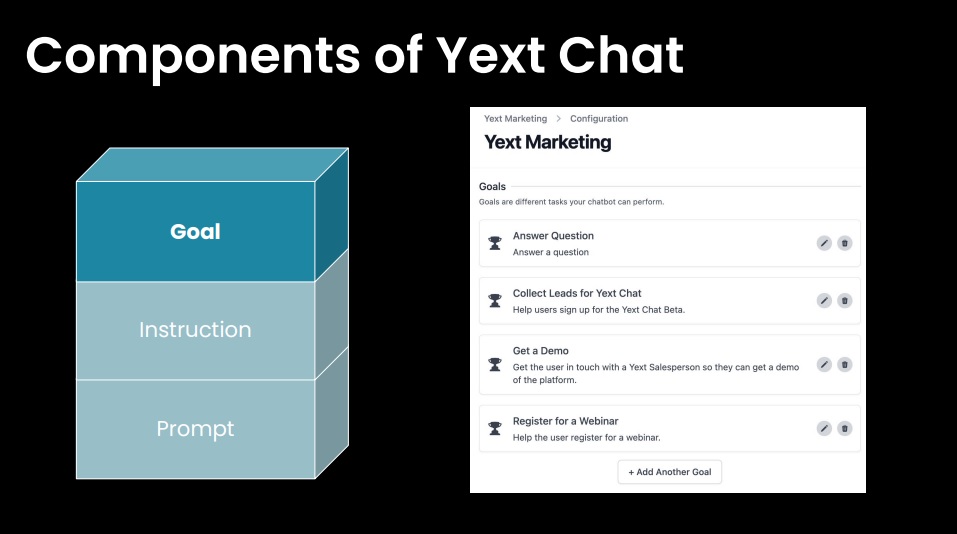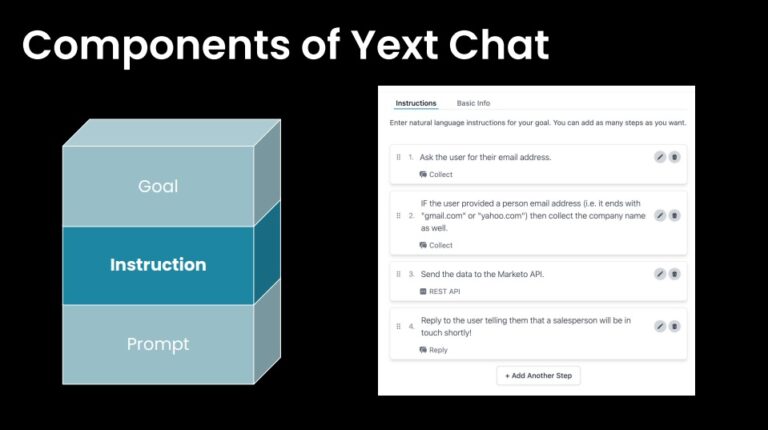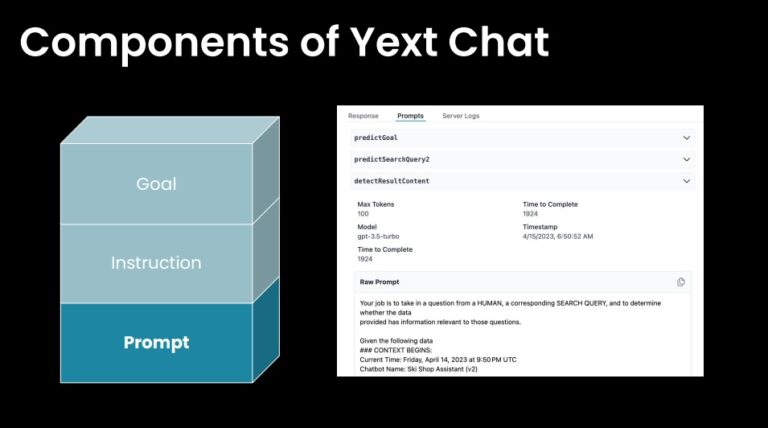
Graham Gillen
Established Digital Experience Management Company Embraces AI
Yext recently announced the launch of Yext Chat, their enterprise solution for delivering conversational user experiences with cutting-edge AI. As a Yext service and delivery partner, Pureinsights had the opportunity to attend a partner briefing on their chat offering. Here are our first impressions of Yext Chat, which we previewed in Beta, but which is now Generally Available.
How AI is disrupting the Chat / Chatbot Industry
Before we get into the specifics of Yext Chat, we should address how AI is disrupting the chatbot industry.
It’s amazing to consider that, before the launch of ChatGPT last November (only eight months ago!) the chatbot industry was in a state of “fatigue.” As we touched on in our blog on ChatGPT:
- Users had developed a disdain for chatbots on websites or their phones.
- When interactions were clumsy or confusing, you always knew a chatbot was involved.
- Only a fraction of user needs were addressed, leaving users frustrated.
- Without easy escalation to a live person, bad chatbot experiences could damage customer relationships.
From a developer perspective, chatbots proved difficult to develop and maintain. Enterprises had to design scripted experiences around a specific series of intents, and it was impractical or costly to try to address more than a dozen of these well.
Just when we all concluded chatbots were overhyped and had hit a dead end, the viral success of ChatGPT breathed new life into the industry. Users marveled at ChatGPT’s ability to understand complex queries and intents, and to generate nuanced, human-like responses – in over 50 languages!
So, chatbots are “dead” only in the sense that they will likely be replaced by conversational AI experiences. And it is technologies like generative AI and Large Language Models (LLMs) that are driving this change.
Why Chat is a natural fit for Yext
As a longtime Yext integration partner, Pureinsights is very familiar with the company’s management and technology. From the information gathered at the partner briefing, we are comfortable saying that the Yext platform is a natural home for the technology offering called Yext Chat, powered by generative AI and Large Language Models for the following reasons:
- Pioneer in Question Answering: Yext is an established digital experience platform company. The Yext platform pioneered the concept of full question answering experiences instead of just traditional keyword search.
- Proven in Multiple Industries: Yext already provides a powerful Digital Experience Platform (DXP) across all industries, from e-commerce, to healthcare, financial services, and consumer packaged goods. These are all segments where exceptional online experiences are critical to brand perception, customer loyalty, and revenue generation.
- Existing Infrastructure: Yext is an established platform that specializes in providing businesses with tools for managing and optimizing their online presence across various digital channels. It already has the infrastructure, integrations, and customer base in place, making it a logical choice to introduce new technologies like Yext Chat.
- Seamless Integration: Yext Chat can integrate seamlessly with other components of the Yext platform, such as content management (CMS), listings management, pages, and reviews. This integration allows for a unified experience and a comprehensive solution for businesses to manage their customer interactions. The access to this content to further train LLMs results in chat responses that are adaptive and much better tuned to users of a specific website.
- Natural Language Processing (NLP) Expertise: Generative AI and Large Language Models, like the one used in Yext Chat, rely on sophisticated NLP algorithms to understand and generate human-like text responses. Yext has expertise in NLP and has developed or partnered with AI specialists to leverage these technologies effectively.
- Customer Engagement: Yext Chat, powered by generative AI, enables businesses to provide automated customer support and engage with website visitors or customers in real-time. These AI-powered chatbots can understand user queries, provide relevant information, and even handle more complex interactions. This enhances customer engagement, improves response times, and allows businesses to scale their customer service efforts.
- Scalability and Efficiency: Large Language Models, such as those used in Yext Chat, are designed to handle vast amounts of data and learn from it, improving their responses over time. By leveraging generative AI, Yext Chat can efficiently handle numerous simultaneous conversations, ensuring businesses can provide personalized and timely support to their customers at scale.
- Adaptability and Learning: Large Language Models have the capability to learn from new information and adapt to different domains and contexts. This adaptability allows Yext Chat to understand industry-specific terminology, customer preferences, and evolving trends, making it a flexible tool for businesses operating in various sectors.
By combining Yext’s existing platform infrastructure, expertise in NLP, and the power of generative AI and Large Language Models, Yext Chat becomes a natural extension of the Yext platform, providing businesses with an intelligent and efficient solution for customer engagement and support.
Yext Chat: a more intuitive development experience
Anyone that has ever worked with development tools for traditional chatbots knows that both the development process and tools can be complicated. User “intent” has to be translated into transaction flows and often backed up with some coding.
Based on the demo we saw, Yext Chat takes a similar but more intuitive approach, though we will reserve final judgment until we’ve had a chance to work with the tool more in depth.
When you first create a Yext Chat, you configure an initial phrase like “Welcome to Ski Warehouse. How can I help you today?” Also part of the configuration is a prompt, such as “You are a bot for Ski Warehouse, a ski equipment retailer with locations across the western US.” Anyone who has played with ChatGPT knows that this type of prompt creates context for the types of responses you want the AI to generate.
Yext Chat development consists of three components: Goal, Instruction, and Prompt.
Similar to “intent” in traditional chatbots, Goals are the high-level intent or objectives you want the chatbot to fulfill. The first step of every chat response is to detect the users’ goal. For example: answering support questions, or recommending products.
Certain goals might revolve around specific answers to questions, like “what is the address of your Boulder, CO store?” Other goals may dictate a conversational interaction, like “can you recommend a set of skis for me?”, where Yext Chat would ask the user more questions before providing an answer via an interface to a recommendation engine.

Instructions are the steps the chatbot should go through to address a goal. Instructions are defined mostly in natural language, and can include branching logic. Yext instruction types include search (data source), API call, Collect (data from user), Reply (to user), or conditional (If).
For direct questions like “what is the address of your Boulder, CO store?” Yext retrieves the answer from its knowledge base, which can include FAQs, CMS, or knowledge graph. This manages the “domain” for direct question answering and eliminates any concerns of “hallucinations” in the LLM. For conversational goals like “can you recommend a set of skis for me?”, Yext Chat can be configured to ask questions, collect parameters, and submit a query via an API to a back-end system for a response.

Every Instruction Type has a prebuilt set of one or more Prompts, which are sent to OpenAI’s ChatGPT. If you have played with ChatGPT, prompts are your way of articulating your request or question in a way that guides the AI towards a desired outcome. For example “put this data into a table” or “rewrite this paragraph for a 6th grade level.”
Yext Chat Prompts are scaffolded; they are the same format for every instance of an instruction, but the Context for each prompt changes. Context includes things like the message history, previous steps, search results, etc.

Once your Yext Chat has been configured, Yext offers a number of easy ways to integrate the chatbot including:
- Embed Code – a configurable snippet to quickly add chat to your site
- Yext Chat SDK – for a more bespoke interface, like one a full-page, branded, ChatGPT-like UI
- API Connection – a version of the SDK that uses API calls exclusively; suitable for applications that may not be browser-based.
The Yext Chat demo we received was much more detailed, but this gives you the flavor as to what the developer experience is like. We were impressed with how it was thought out and implemented.
Recommendations from our Yext Chat Overview and First Impressions
Here are our current observations and recommendations after our initial exposure to Yext Chat.
- Before we even saw a demo of Yext Chat, it was already clear to us Chat was a natural extension to the Yext Platform. Yext customers have been asking about Chat for a while, and bypassing the old approach and embracing new AI-technologies is absolutely the right way to go.
- An AI-driven chatbot by itself is useful. But integrated onto a platform with the right content to drive its behavior is also a big plus. We think every existing Yext customer should be thinking about how to integrate Yext Chat into their website.
- Companies looking for a CMS or DXP should consider platforms like Yext, with built-in AI chat capabilities. There’s really no sense in having to manage the integration of a third-party chat tool with your primary website platform.
- After previewing the Yext Chat Beta, we look forward doing a deeper dive into the platform now that it is Generally Available. One question we have for anyone using third-party LLMs is whether or not they can meet latency requirements for high-volume transaction customers. To a great extent, this is outside of Yext’s control.
- There is a recurring and variable cost to using LLMs like OpenAI’s ChatGPT and pricing for Yext Chat was not available at the writing of this blog. However, prices have already been plummeting, and we expect the added cost to compare favorably with the costs of maintaining old-style chatbots that don’t work as well.
- OpenAI is just one LLM vendor, with Microsoft being a major investor. We expect the number of LLMs to explode in the next 12 months, but we expect the top offerings to come from the big cloud providers like Microsoft Azure (OpenAI / ChatGPT), Google Cloud (Bard / Pa LM2), and Amazon (Bedrock). Yext may look into giving users a choice of LLMs depending on what the market dictates.
- Another consideration is whether or not we will see a merging of search bars and chat interfaces on websites. Will consumers prefer just dealing with a single interface for search as well as for support purposes? Could the new generation of search bars just offer a “chat” button that puts the UI into a mode similar to Chat mode? This is one more development that would benefit Yext Chat.
As a final thought, we want to acknowledge that we were thoroughly impressed with the Yext staff we interfaced with in learning about the new Yext Chat capability. If you put a premium on doing business with companies you enjoy interacting with, then that should certainly be taken into consideration.
If you have any further questions, you can CONTACT US or reach out to your Yext representative if you are already a customer.